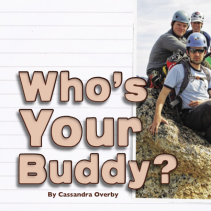Who’s Your Buddy?
Written for Washington Trails magazine
Visit the published article here
As avid hikers—or aspiring avid hikers—we usually invest a significant amount of energy in planning our time in the outdoors. We memorize the Ten Essentials and keep our backpacks stocked with energy bars, extra socks and enough maps to outfit an invading army. We study weather forecasts and plan our hikes by season, hoping that all of our efforts will guarantee great days on the trail—fair weather, breathtaking views and successful summits. And yet, in our quest to remember everything from bandages to blister cream, many of us forget a simple truth: the only difference between a good day on trail and a great day on trail is having the right companions to share it with.
This is never truer in life than in hiking. Let’s face it, the outdoors puts true companionship in perspective. A good hiking buddy is someone who sees you in the most challenging of circumstances— when you’re exhausted, dirty and drenched—and can make you smile at the humor of it all. They understand when you need to rest and encourage you to push on just a little more. They are someone with whom you’ll reminisce and laugh for years to come, about the time marmots raided your backpack or the midnight rainstorm that flooded your tent.
Whether you’re looking for someone to share memories, logistics or expenses, finding the right hiking partner can vastly improve your outdoor experiences. It can give you the opportunity to glimpse the outdoors not only through your own eyes, but through another’s as well. Hiking with a companion or group can also offer a sense of security in knowing that should an accident or injury occur, help is nearby.
Step One: What Kind of Companion Do You Want?
The first step in finding a hiking companion is getting a clear idea of the type of experience you’re looking for. Be honest with yourself. Hiking is an exercise in endurance and can test people’s patience and character. The more accurate you can be, the better your chances of connecting with a like-minded partner—and the happier you’ll both be on the trail. Here are some things to consider.
What hiking companionship have you enjoyed in the past?
Start by analyzing your previous hiking friendships. What did you enjoy, or not enjoy? Determine what to repeat or avoid with your next buddy.
What aspects of companionship are you looking for?
Are you looking for someone who will be strictly a hiking companion, or would you like a broader relationship that includes other hobbies and dating?
What are your preferences for hiking with groups or individuals?
Groups are great for socializing and meeting new people, but may be slower on the trail, while individual partners may offer the potential for deeper friendships.
What kind of experience are you looking for?
Everyone has an objective for getting outdoors. What is yours? Do you want to learn about the environment? Get in shape? Practice photography? Bag summits?
What kind of hiker are you?
This is one of the most important questions to answer honestly. Are you more of a trail chaser or a casual plodder? Do you have kids who could slow a group down? Do you have health conditions or physical limitations that affect your speed?
What kind of hiker do you want to be?
Are you looking to improve your hiking fitness and need to be encouraged? Are you a slow hiker but would like to get faster? Are you a little out of shape and would like to develop muscle tone and improve your endurance?
Once you have determined what kind of hiker you are, and what kind of companion you’re looking for, you’re ready to move on to step two.
Step Two: Where to Find Your Next Hiking Companion
Once you identify the kind of hiking experience and companion(s) you’re looking for, it’s time to browse the organizations, classes and websites currently available to help connect you with your ideal outdoor adventure. There are extensive opportunities across the state to connect with like-minded hikers, ranging from community and fitness groups to hobby and enthusiast meetings. Try several and see what develops.
(List and links available in published article)
Step Three: Know Before You Go
You’ve searched the groups, you’ve made connections and now you’re ready to hit the trail with your new hiking group or partner. To guarantee that things go smoothly on your first outing, here are some things to keep in mind.
- Do your research and know what to expect on hiking day. A conversation with your new companion or group leader can help avoid first-day awkwardness. Make sure you discuss logistics, including carpooling or contributing money to a gas fund, punctuality, RSVPs and speed or performance expectations.
- Remember that you alone bear the ultimate responsibility for your own safety and well-being. Hiking with another person, or an entire group, can give you a false sense of security. You should always carry your own Ten Essentials. Also, be prepared for group- think and the possibility that you might need to turn back on your own if a particular section of trail is out of your comfort zone.
- When you’re meeting your group or partner for the first time, avoid conversations on touchy subjects, e.g., politics and religion—unless you’re meeting with that specific type of group. Share some of your favorite trails hiked, volunteer experiences, books read or food—everyone loves food.
- Finally, just be the kind of person that you want to meet. It doesn’t matter if you’re feeling nervous or shy. Chances are, other people will be feeling the same. Flash your best smile; be friendly and ready to participate in a fun outing. It may not be long before you end up with a hiking companion who’s also your best friend.
So whether you’re hiking for the first time, fifth time or fiftieth time, and you’re looking for a buddy or group to share some quality trail time with, there are an abundance of resources just waiting to help you make those connections. All you need to do is determine what you’re looking for and reach out. Chances are, there are quite a few fellow hikers out there looking for the same thing.
As you get ready for another great hiking season, make this the best one yet by expanding your outdoors community. Before you know it, your time on the trail will be filled with more laughter, more fun and maybe even some homemade chocolate chip cookies. It doesn’t get much better than that.
Tips for Starting Your Own Hiking Group:
You don’t need to join someone else’s hiking group to find new hiking partners. Often, the people in your existing communities— work, church and neighborhood—can make great companions too. Look around where you live and play.You might just find others who have been waiting for an invitation to join you on the trail.
Here are some tips for starting your own hiking group:
- Invite people who are cooperative and get along.
- Set group expectations together so everyone is comfortable.
- Discuss punctuality, RSVPs, carpooling and a group policy on dogs.
- Determine your collective fitness level and plan hikes accordingly.
- Schedule in advance and hike regularly.
- Take turns with trip planning and logistics.


